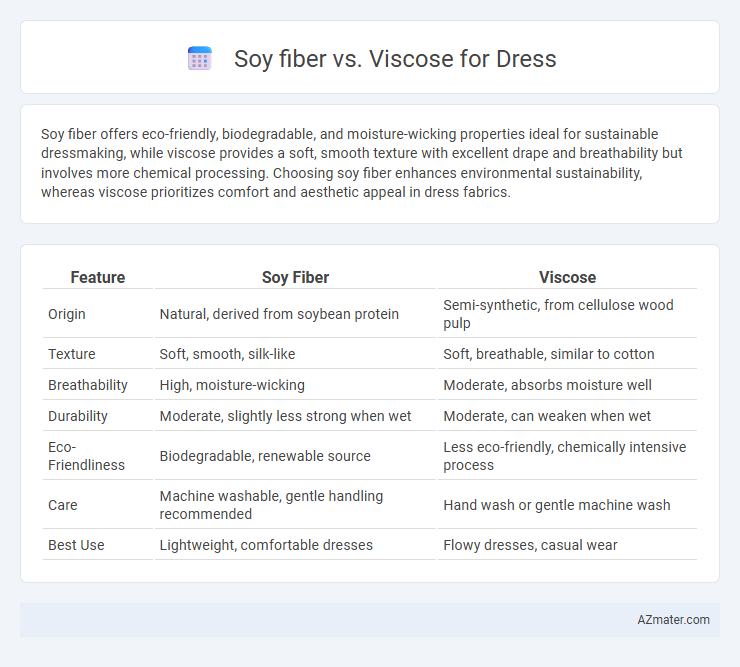Soy fiber offers eco-friendly, biodegradable, and moisture-wicking properties ideal for sustainable dressmaking, while viscose provides a soft, smooth texture with excellent drape and breathability but involves more chemical processing. Choosing soy fiber enhances environmental sustainability, whereas viscose prioritizes comfort and aesthetic appeal in dress fabrics.
Table of Comparison
| Feature | Soy Fiber | Viscose |
|---|---|---|
| Origin | Natural, derived from soybean protein | Semi-synthetic, from cellulose wood pulp |
| Texture | Soft, smooth, silk-like | Soft, breathable, similar to cotton |
| Breathability | High, moisture-wicking | Moderate, absorbs moisture well |
| Durability | Moderate, slightly less strong when wet | Moderate, can weaken when wet |
| Eco-Friendliness | Biodegradable, renewable source | Less eco-friendly, chemically intensive process |
| Care | Machine washable, gentle handling recommended | Hand wash or gentle machine wash |
| Best Use | Lightweight, comfortable dresses | Flowy dresses, casual wear |
Introduction to Sustainable Dress Fabrics
Soy fiber, derived from soybean protein, offers a natural, biodegradable alternative known for its softness and moisture-wicking properties, making it ideal for eco-friendly dress fabrics. Viscose, a semi-synthetic fiber produced from cellulose, provides a smooth, breathable texture but involves chemical processing impacting sustainability. Choosing soy fiber over viscose supports reduced environmental footprint through renewable sourcing and less chemical use in sustainable dress manufacturing.
What is Soy Fiber?
Soy fiber, also known as soybean fiber or Azlon, is a natural, protein-based textile made from the byproducts of soybean processing. It offers excellent moisture absorption, softness, and breathability, making it an eco-friendly alternative to synthetic fibers in dress fabrics. Viscose, on the other hand, is a semi-synthetic fiber derived from wood pulp, known for its smooth texture and drape but less sustainable compared to soy fiber.
Understanding Viscose: Features and Origins
Viscose, a semi-synthetic fiber derived from cellulose found in wood pulp, offers a silky texture and excellent breathability, making it a popular choice for dresses. Unlike soy fiber, which is plant-based and valued for its moisture-wicking properties and sustainability, viscose provides a smooth drape and vibrant dye retention but may require careful care to avoid shrinking or damage. Understanding viscose's wood pulp origin and its processing through chemical treatment highlights its versatility and the importance of responsible sourcing to reduce environmental impact.
Environmental Impact: Soy Fiber vs Viscose
Soy fiber, derived from soybean protein, is a sustainable textile option due to its renewable source and biodegradable nature, resulting in a lower environmental footprint compared to viscose. Viscose production involves chemically intensive processes and significant water consumption, contributing to deforestation and pollution issues. Choosing soy fiber for dresses supports eco-friendly manufacturing and reduces reliance on resource-heavy viscose fabrics.
Comfort and Wearability Comparison
Soy fiber offers superior softness and breathability compared to viscose, making it ideal for comfortable dress wear in warm climates. Viscose, while smooth and lightweight, tends to retain moisture longer, potentially reducing comfort during extended wear. The natural moisture-wicking properties of soy fiber enhance breathability and keep the skin dry, resulting in higher wearability and comfort in dresses.
Durability and Longevity in Dresses
Soy fiber, derived from soybean protein, offers moderate durability for dresses but is generally less resistant to wear and tear compared to viscose. Viscose, made from regenerated cellulose fibers, provides better tensile strength and tends to maintain its shape and color longer under regular use. When considering longevity, viscose dresses typically outperform soy fiber garments due to their enhanced durability and resistance to fabric degradation over time.
Breathability and Moisture Management
Soy fiber offers superior breathability compared to viscose, making it ideal for dresses worn in warm or humid conditions. It naturally wicks moisture away from the skin, ensuring enhanced comfort and dryness throughout the day. Viscose, while soft and smooth, tends to retain moisture longer, which can reduce its breathability and lead to less effective moisture management in garments.
Style and Aesthetic Differences
Soy fiber offers a natural, matte finish with a subtle sheen that enhances the softness and drape of dresses, providing a more organic and eco-friendly aesthetic suitable for casual and elegant styles. Viscose delivers a smooth, lustrous surface with a silky texture that reflects light, creating a vibrant and luxurious appearance favored in formal and high-fashion dress designs. The style difference lies in soy fiber's understated, earthy elegance versus viscose's glossy, refined look that elevates overall garment sophistication.
Price and Availability in the Market
Soy fiber offers a competitive price point compared to viscose, often appealing to eco-conscious consumers seeking affordable sustainable fabrics. Viscose is widely available in global markets due to its established production, but its price fluctuates based on raw material sourcing and manufacturing scale. Both fibers provide versatile options for dress fabrics, with soy fiber gaining traction in niche markets while viscose remains more accessible in mainstream textile supply chains.
Choosing the Right Fabric for Your Dress
Soy fiber offers a sustainable, biodegradable option with a silky texture and excellent moisture absorption, making it ideal for eco-conscious dressmakers. Viscose, derived from wood pulp, provides a soft, breathable fabric with a smooth drape, perfect for elegant, flowing dresses but involves more chemical processing. Choosing the right fabric depends on balancing environmental impact, fabric feel, and dress design requirements to ensure comfort, style, and sustainability.

Infographic: Soy fiber vs Viscose for Dress
 azmater.com
azmater.com